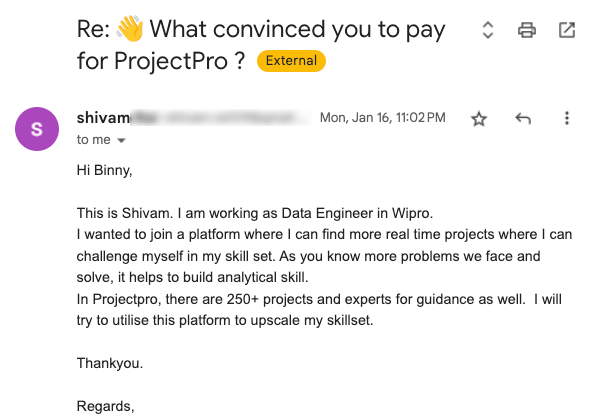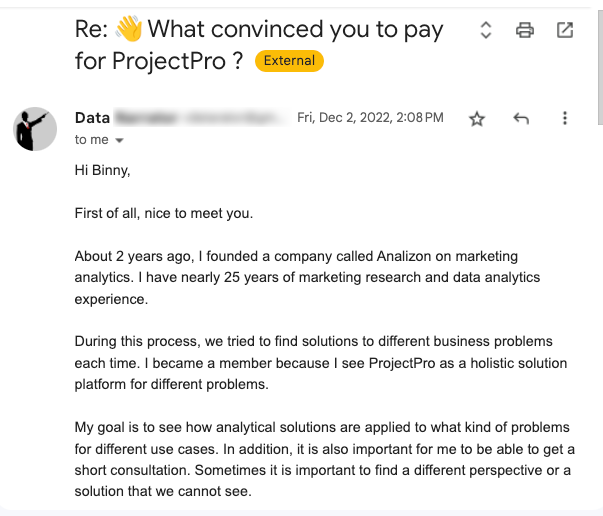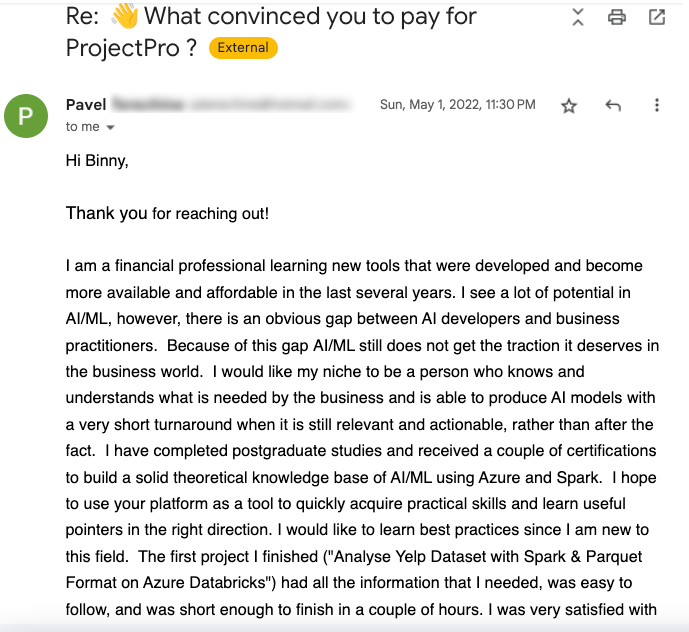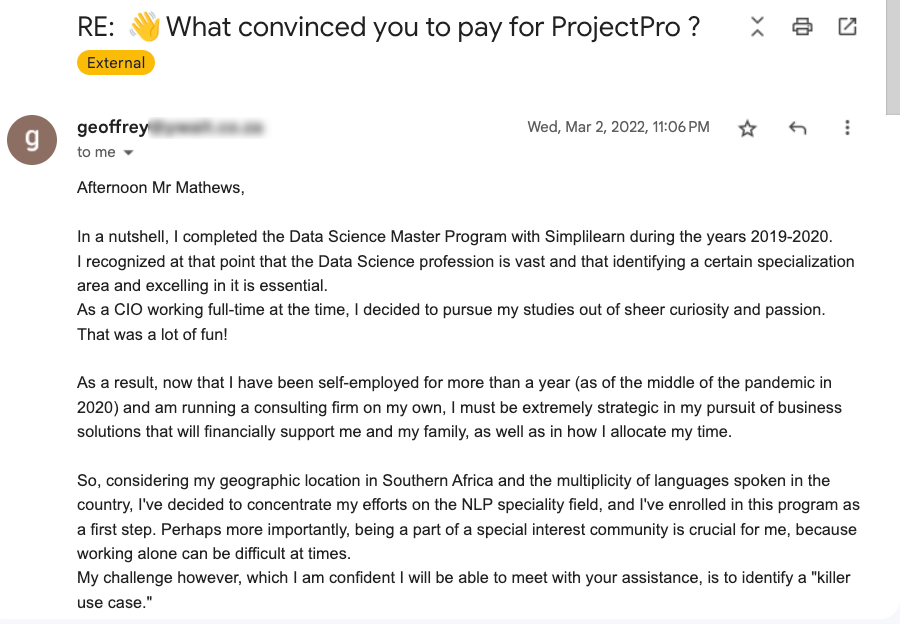
Senior Data Platform Engineer, GoodRx

Big Data Engineer, Beyond Limits

University of Economics and Technology, Instructor

Principal Data Scientist - Cyber Security Risk Management, Verizon
The goal of the BigMart Sales Prediction ML project is to build and evaluate different predictive models and determine the sales of each product at a store.
Get started today
Request for free demo with us.
Schedule 60-minute live interactive 1-to-1 video sessions with experts.
Unlimited number of sessions with no extra charges. Yes, unlimited!
Give us 72 hours prior notice with a problem statement so we can match you to the right expert.
Schedule recurring sessions, once a week or bi-weekly, or monthly.
If you find a favorite expert, schedule all future sessions with them.
Source: ![]()
Source: ![]()
Source: ![]()
Source: ![]()
Source: ![]()
Source: ![]()
Source: ![]()
Source: ![]()
Source: ![]()
Source: ![]()
Source: ![]()
Source: ![]()
Source: ![]()
250+ end-to-end project solutions
Each project solves a real business problem from start to finish. These projects cover the domains of Data Science, Machine Learning, Data Engineering, Big Data and Cloud.
15 new projects added every month
New projects every month to help you stay updated in the latest tools and tactics.
500,000 lines of code
Each project comes with verified and tested solutions including code, queries, configuration files, and scripts. Download and reuse them.
600+ hours of videos
Each project solves a real business problem from start to finish. These projects cover the domains of Data Science, Machine Learning, Data Engineering, Big Data and Cloud.
Cloud Lab Workspace
New projects every month to help you stay updated in the latest tools and tactics.
Unlimited 1:1 sessions
Each project comes with verified and tested solutions including code, queries, configuration files, and scripts. Download and reuse them.
Technical Support
Chat with our technical experts to solve any issues you face while building your projects.
7 Days risk-free trial
We offer an unconditional 7-day money-back guarantee. Use the product for 7 days and if you don't like it we will make a 100% full refund. No terms or conditions.
Payment Options
0% interest monthly payment schemes available for all countries.
Sales forecasting enables businesses to allocate resources for future growth while managing cash flow properly. Sales forecasting also assists firms in precisely estimating their expenditures and revenue, allowing them to predict their short- and long-term success. Retail Sales Forecasting also assists retailers in meeting customer expectations by better understanding consumer purchasing trends. This results in more efficient shelf and display space use within the retail establishment, thus, higher sales and optimal use of inventory space.
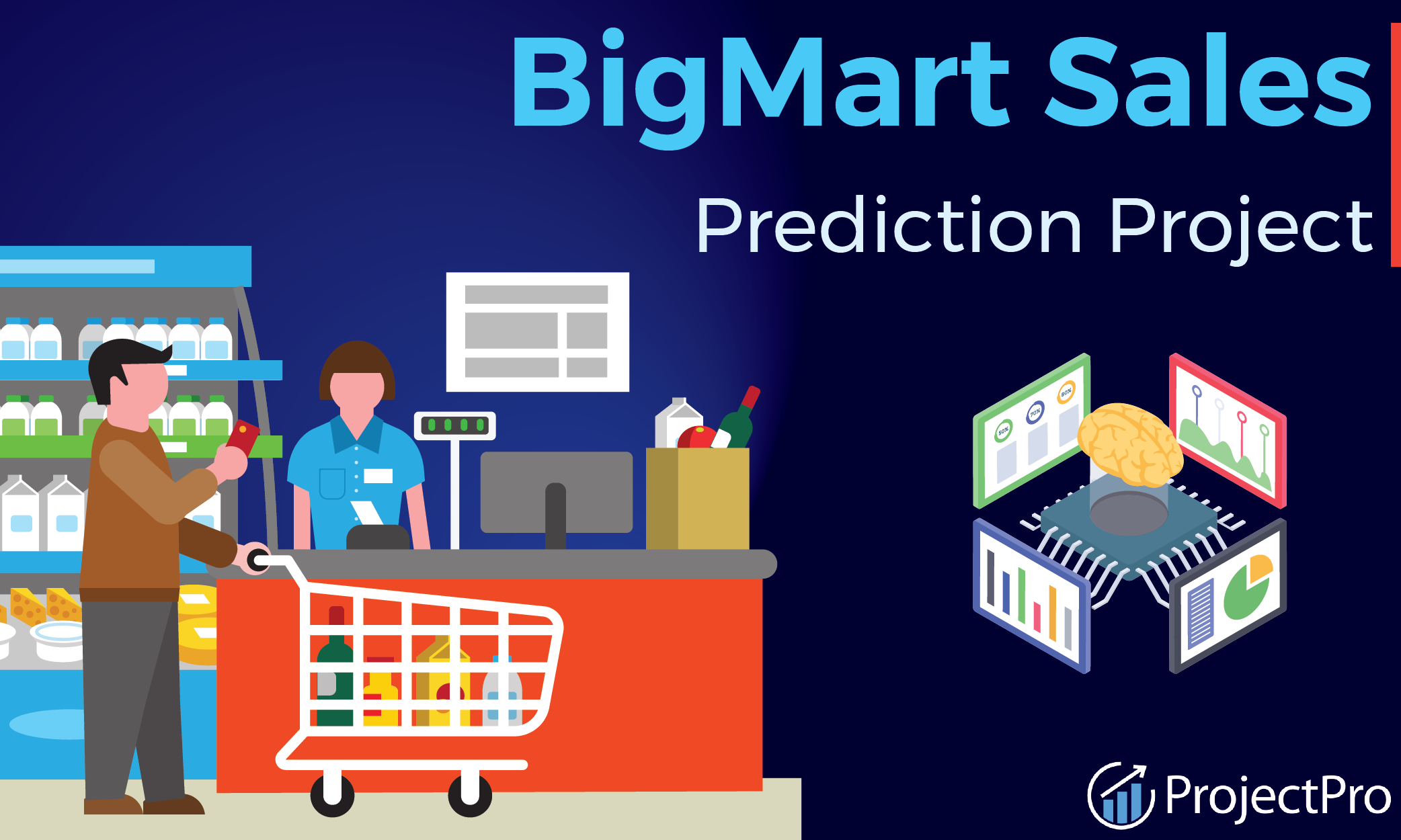
This data science project aims to build and evaluate different predictive models and determine the sales of each product at a particular store. This analysis will help BigMart understand the properties of products and modify categories and stores, which are crucial in increasing sales and developing better business strategies.
For this ML sales prediction project, we will use the BigMart sales prediction dataset that contains 2013's annual sales records for 1559 products across ten stores in different cities. Such vast test data sets can reveal insights about apparent customer preferences for a specific product and a particular store whose attributes have been defined in the BigMart Sales dataset.
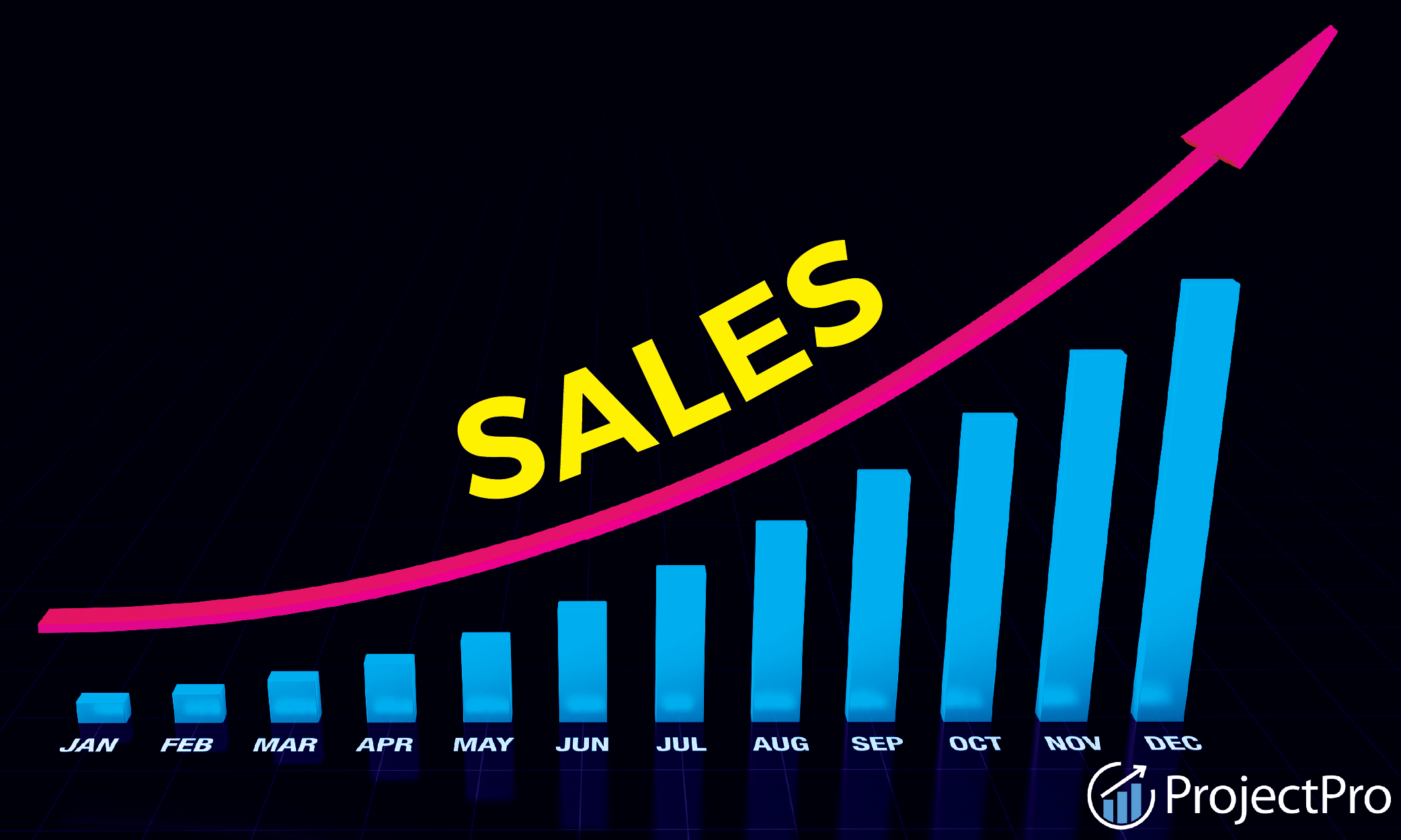
Language: Python 3.8.10
Libraries: Pandas, NumPy, matplotlib, sklearn, AWS Redshift connector, Pyearth, Pygam
The Bigmart sales forecast project can help you comprehend project creation in a professional atmosphere. Here are the key learning takeaways from this sales prediction ML project-
This project will teach you how to extract and process data in the Amazon Redshift database before further processing and building various machine-learning models for sales prediction.
You will learn several data processing techniques, exploratory data analysis, and categorical correlation with Chi-squared, Cramer’s v tests, and ANOVA.
In addition to basic statistical models like Linear Regression, you will learn how to design cutting-edge machine-learning models like Gradient Boosting and Generalized Additive Models.
By working on this project, you will also explore splines and multivariate adaptive regression splines (MARS), ensemble techniques like model stacking and model blending, and learn how to evaluate these models for the best results using metrics like MAE, RMSE, etc.
Let us understand the working approach used in this Big Mart Sales Prediction project.
Data Exploration with Amazon Redshift
Data Cleaning and Imputation
Exploratory Data Analysis
Categorical Data
Continuous Data
Correlation
Pearson’s Correlation
Chi-squared Test and Contingency Tables
Cramer’s V Test
One way ANOVA
Feature Engineering
Outlet Age
Label Encoding for Categorical Variables
Data Split
Model Building and Evaluation
Linear Regressor
Elastic Net Regressor
Random Forest Regressor
Extra Trees Regressor
Gradient Boosting Regressor
MLP Regressor
Multivariate Adaptive Regression Splines (MARS)
Spline Regressor
Generalized Additive Models - LinearGAM, PoissonGAM, GammaGAM
Voting Regressor
Stacking Regressor
Model Blending
In this sales prediction project, you will use the BigMart sales dataset with a store and item_ID combination and several other attributes. The BigMart sales dataset is a collection of information about sales data from a fictional store called BigMart. It contains a bunch of data points that can help us understand how different factors impact the sales of products in the store.The dataset provides us with various pieces of information for each product sold at BigMart. These include things like the product's unique identifier, its type (such as fruits, vegetables, or household items), the size or weight of the product, its retail price, and other attributes that describe the product. This dataset helps data scientists answer questions like -
What factors influence the sales of a particular product? Is it the product's price, its size, or the store location?
Are certain types of products more popular in specific outlets or regions?
Can we predict the sales of a product based on its attributes and other variables like store location and size?
Are there any particular trends or patterns in the sales data that can help us optimize inventory management or pricing strategies?
The dataset also gives us details about the store and the sales transactions. For example, we can find information about the store's location, the type of outlet (whether it's a supermarket or a grocery store), the establishment year of the store, and the size of the store. The entire dataset (8523 rows) is in a Redshift database where you will query it using SQL and check for any missing values, null values, etc. You will also need to preprocess the clean data in Python and use statistical tests to check whether significance exists between categorical variables, etc.
Here are some of the attributes defined in the BigMart Sales Prediction dataset-
item_identifier: unique identification number for particular items
item_weight: weight of the items
item_fat_content: fat content in the item such as low fat and regular fat
item_visibility: visibility of the product in the outlet
item_type: category of the product such as Dairy, Soft Drink, Household, etc
item_mrp: Maximum retail price of the product
outlet_identifier: unique identification number for particular outlets
outlet_establishment_year: the year in which the outlet was established
outlet_size: the size of the outlet, such as small, medium, and high
outlet_location_type: location type in which the outlet is located, such as Tier 1, 2 and 3
outlet_type: type of the outlet such as grocery store or supermarket
item_outlet_sales: overall sales of the product in the outlet
This big mart sales machine learning project involves basic data cleaning using SQL queries. Once you log in to the Redshift database, you can explore your dataset using SQL queries and check for missing and null values in it.
Handling Missing and Null Values - Check for missing values in the dataset. For instance, the "Item_Weight" column might have missing values. Decide on an appropriate strategy to handle these missing values. You could fill in the missing values with the average weight of similar products or use more advanced techniques to estimate missing values based on other relevant variables.
You will determine and fill the missing and null values in the dataset columns (e.g., outlet_size, item_weight, etc.) using SQL queries. You will write SQL queries to update the table ‘public_data’ and fill in the missing values in the item_weight column with the calculated mean value for any specific item_type. Alternatively, you can drop down the rows with missing/null values if you find them irrelevant to your solution. To fill the missing/null values in the outlet_size column, you will connect the Redshift database to the Python colab environment and then update those values using Python and SQL queries.

The next step in this ML prediction project is to perform exploratory data analysis on the dataset -
Categorical Variables- You will analyze each dataset column separately and eliminate recurring values. Identify categorical variables like "Outlet_Location_Type" and "Outlet_Type." Encode these variables using techniques like one-hot encoding, creating binary columns for each category, or ordinal encoding, assigning numerical values based on the category's order or significance. You will also plot some graphs and visualizations using Python libraries, like Seaborn, for various categorical variables, including outlet_size, outlet_type, outlet_establishment_year, etc.
Continuous Variables- Next, you will generate distplots using the Python library ‘Seaborn’ for continuous variables like item_weight, item_visibility, etc. You will also generate lmplots (linear modeling plots) to visualize the linear relationship between these variables.
This project explores various correlation analysis techniques to determine the correlation between the categorical variables in the dataset. You will use Chi-squared Test with a 2x2 contingency table to identify correlations between the categorical variables (outlet_type and outlet_size) and their statistical significance. You will use Cramer’s V Test on three columns (outlet_size, outlet_type, and location_type) to measure the strength of association between these categorical variables. You will also use the One-way ANOVA technique to find the correlation between a numeric variable (item_outlet_size) and a categorical variable (outlet_size).
Once you finish data exploration, you will move on to the next step in this sales prediction data science project, i.e., feature engineering. This step involves adding certain features to the dataset, or modifying the existing features, such as replacing the values containing '0' with some new values in the 'item_visibility' column, etc. You will check whether the 'outlet_establishment_year' impacts the store sales by creating a new column, 'outlet_age'. You will also encode some of the columns, including item_fat_content, outlet_identifier, etc. Before passing the processed data to the next step, i.e., model building, you will split the dataset into train and test datasets.
Several machine learning models are used in this project, such as Linear Regression, ElasticNet, Random Forest, Extra Trees, Gradient Boosting, MultiLayer Perceptron, etc. You will find the R-squared value for all these models by creating a basic model selection function and passing various parameters, including your training dataset and the list of models. However, the R-squared value for all these models does not exceed the required value of 0.6, so you will explore new models, such as Multivariate Adaptive Regression Splines (MARS) and Generalized Additive Models (GAM) to build your project solution.

The next step is to import the Pyearth library, which will run the MARS algorithm. You will create a function (spline_model) and pass the required parameters, including knots and degrees, and check whether this model is better than the previous ones. Once you find the results are below average (score 0.5), you will move on to trying out the next model for your solution, i.e., the Generalized Additive Model (GAM).
You will install the Pygam library and import LinearGAM, PoissonGAM, and GammaGAM (distributions upon which the GAM model has been built). You will try any of the GAM models (in this case, PoissonGAM), apply GridSearch on it, and determine the R-squared value for the GAM (0.6869 for PoissonGAM).
Now that you have built the models and obtained their R-squared values, it’s time to improve their performance and accuracy.
Ensemble techniques, such as model voting, stacking, and blending, are commonly used by data scientists in data science projects to improve the performance and accuracy of machine learning models.
Model Voting- This project will explore these three ensemble techniques starting with model voting. You will create three models (Linear Regressor, GBM, and MLP Regressor) and a Voting Regressor along with parameters, including estimators (the three models you create). You will also calculate the cross-validation score for each of the three models and obtain the average R-squared score, which is nearly 0.56.
Model Stacking- Model stacking involves combining the predictions of several models by training a meta-model that takes the outputs of the base models as inputs. For this project,
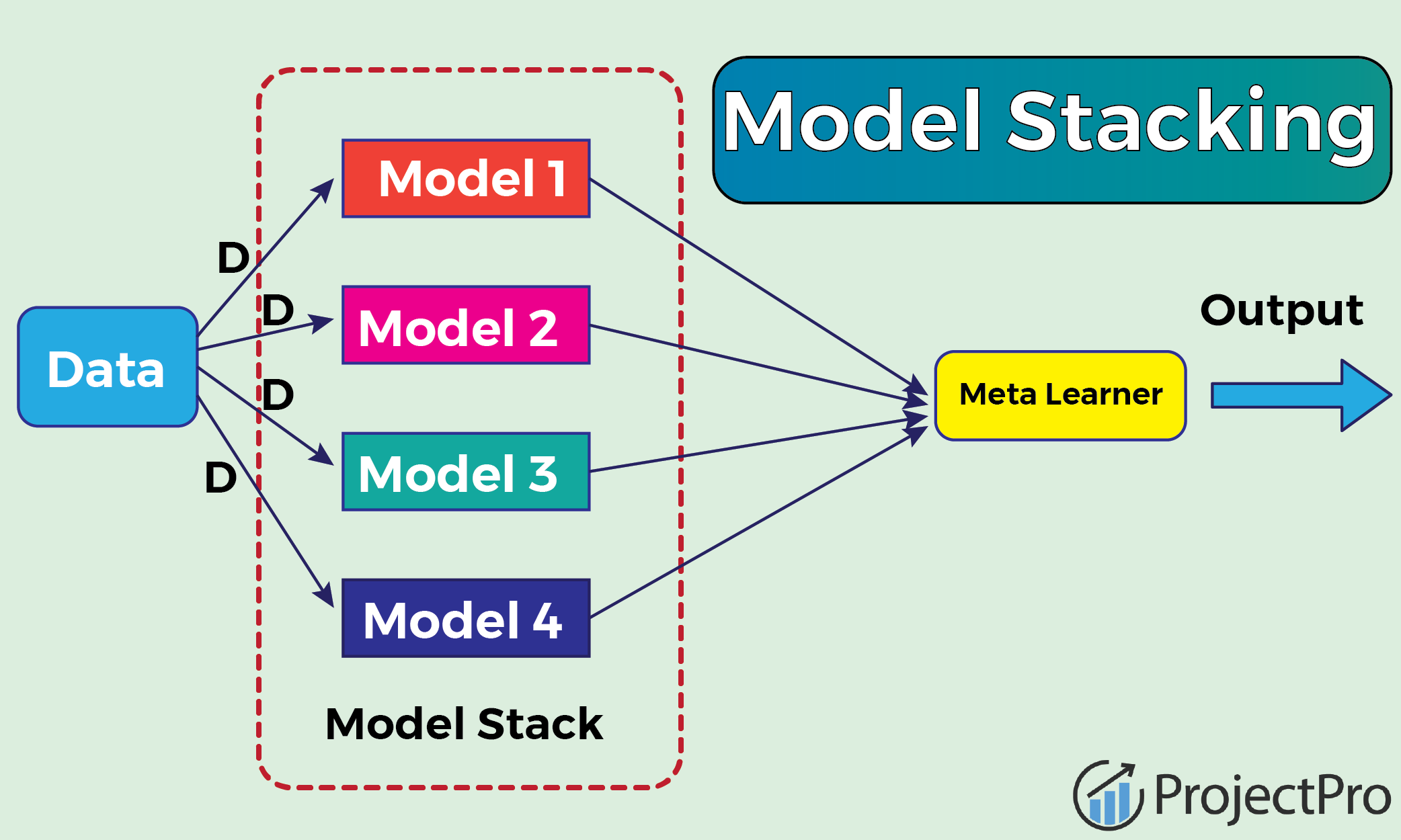
Model Blending- Model blending involves combining the predictions of several models by taking a weighted average of their outputs. Both techniques can help to reduce overfitting and improve model generalization, resulting in better performance on unseen data. In this project, the next step after model stacking is model blending, which requires creating a validation set out of the training set. Then, you will create an append function for the base models (same base models as in Model Stacking). You will also create a function (pred_data) to get first-level predictions on the actual testing data.
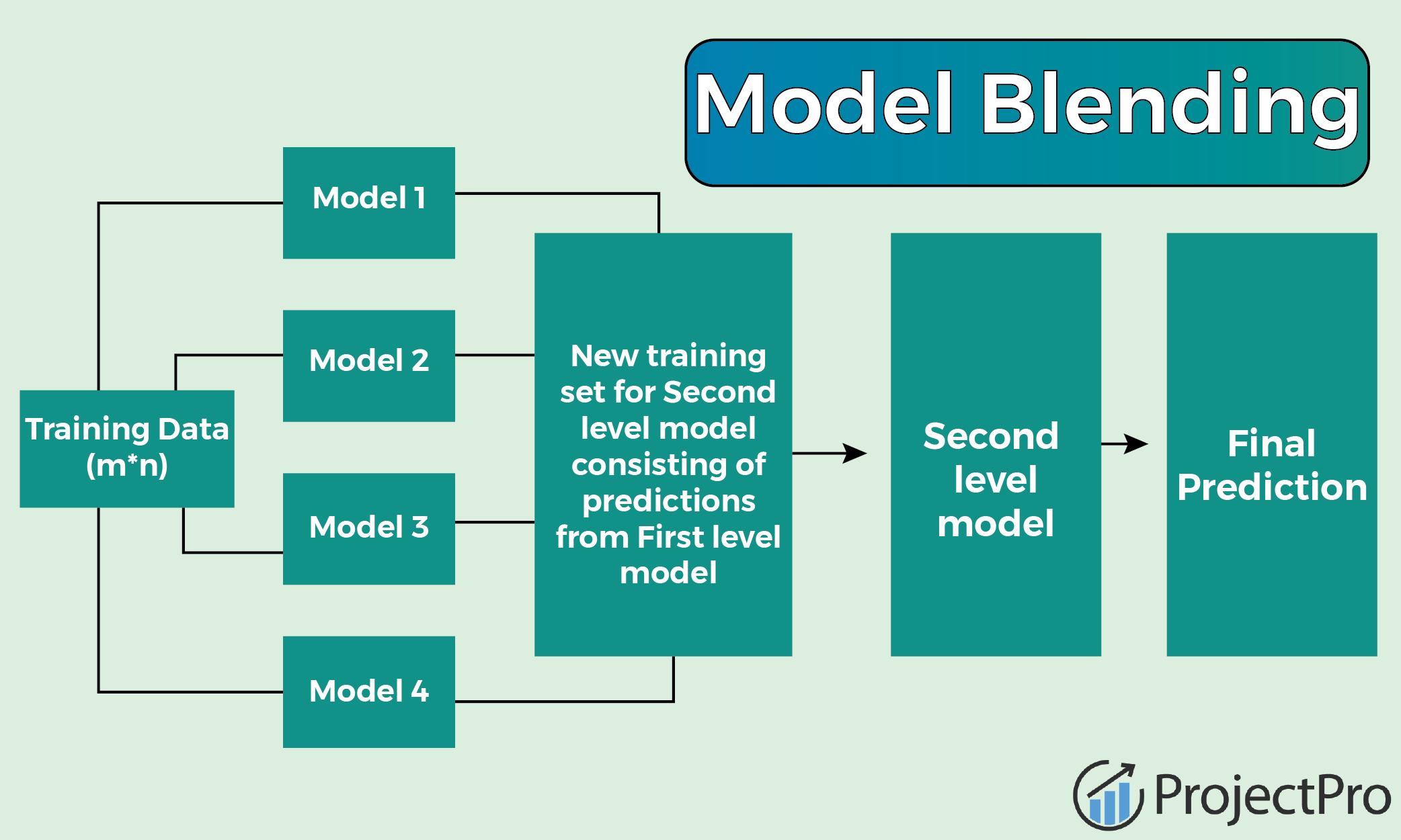
This is the last step of this sales prediction ML project, where you will test the top-performing models (GBM and GAM) on the test data. You will calculate the R-squared scores for all models- blending, stacking, GBM, and GAM (PoissonGAM), out of which the GAM model has the highest score, 0.62; hence, it is the best model to be deployed. You will also create a backup model (GBM and stacking model), which give an average R-squared score of 0.56 and 0.49, respectively.
The next steps in the project solution will involve saving all the encoders and suitable models, performing data validation tests, handling missing/null values in newly-acquired data, generating predictions on the new data, sending results back to the database, and finally deploying the model- firstly in the local system and then on the cloud.
Sales Prediction is helpful for businesses as it empowers them to predict future sales and understand customer demand. By utilizing machine learning algorithms to explore and analyze historical sales data, businesses gain insights that help them make better strategic decisions. For instance, they can determine how much stock to keep, when to launch attractive offers and promotions, which products to focus on, etc.
Now, imagine a retail store using sales prediction to avoid stocking too many winter jackets in a region that rarely experiences cold weather and, instead, stocking more beachwear during summer. How do you think this will impact its overall business growth and customer experience? Sales prediction will allow the retail business to optimize its inventory, pricing, production, and marketing strategies, ensuring it meets customer needs and maximizes overall profits.

Let us look at a few interesting use cases of Sales Prediction across industries-
1. Retail Industry- Sales prediction can be used to forecast sales for various products in a retail store. This can help retailers manage their inventory and ensure they have enough stock to satisfy customer demand.
For instance, a clothing store can use historical sales data to predict the demand for different clothing items during specific seasons. This will ensure they have enough stock of popular items and avoid overstocking on less in-demand products.
2. E-commerce Industry- Online retailers can use sales prediction to forecast sales for different products and categories. This can help them optimize pricing strategies, manage inventory, and meet customer demand.
For instance, an e-commerce platform, like Amazon, can leverage sales prediction to determine the inventory levels for high-demand items during peak shopping seasons, like Black Friday.
3. Food And Beverage Industry- Restaurants and food chains can use sales prediction to forecast sales for different items on their menu. This can help them manage their inventory and ensure they are prepared for busy periods.
For instance, a coffee shop like Starbucks, can use sales prediction to determine peak hours when they need additional staff to handle increased customer traffic. This ensures efficient service and a satisfying customer experience.
4. Consumer Goods Industry- Manufacturers can use sales prediction to forecast product demand. This can help them optimize production schedules, manage inventory, and meet customer demand.
For example, smartphone manufacturers can analyze historical sales data to predict the demand for different variants of their products. This will help them optimize production, plan marketing campaigns, and allocate resources effectively. Consumer goods companies can avoid stockouts and maintain customer satisfaction by accurately predicting product demand.
Let us look at a few real-world applications of Sales Prediction-
1. Walmart: The world's largest retailer, Walmart, uses sales prediction to manage inventory and optimize pricing strategies for their various product categories. They analyze vast amounts of data to predict customer demand, avoiding situations where you buy your favorite snack only to find an empty shelf – such a disappointing shopping experience!
2. Amazon: Amazon, the e-commerce giant, uses sales prediction to forecast demand for various products and categories on its online marketplace. This helps them manage their inventory and ensure they meet customer demand. By analyzing past purchases and user behavior, they can also recommend products you might like based on your previous shopping history. So, you might buy more than you planned, but who can resist those personalized recommendations?
3. McDonald's: The fast-food chain McDonald's, uses sales prediction to forecast demand for different items on their menu. They use historical sales data to estimate demand for various menu items, ensuring they have enough burgers and fries to satisfy hungry customers. So, the next time you are in a rush and craving a burger, thank sales prediction for keeping your favorite fast-food joint well-stocked!
4. Procter & Gamble: Consumer goods manufacturer, Procter & Gamble, uses sales prediction to optimize their production schedules and manage their inventory to meet customer demand. They analyze sales patterns to anticipate demand for their cleaning products, so you can rest easy knowing you won't run out of laundry detergent when you need it the most!
Big Mart Sales Prediction uses machine learning algorithms to analyze historical sales data and forecast future sales for the BigMart retail store chain.
Historical sales data is first collected and preprocessed to predict sales using machine learning. Then, this data helps train a machine-learning regression model. The predictive model itself is trained to recognize patterns in the data and make reliable predictions about future sales based on those patterns. Once the predictive model itself is trained, it can predict sales on new or modified data sets. The accuracy of the predictions is often improved by fine-tuning the model and incorporating additional data sources, such as weather or demographic data, that may impact sales.
An example of sales prediction is using historical sales data to forecast future demand for a particular product or category. For instance, a retailer may analyze past sales of separate categories of winter clothing to predict the demand for winter clothing in the upcoming season.
Recommended
Projects
A Beginner's Guide to AWS Rekognition for Image/Video Analysis
AWS Rekognition - from its robust features, working overflow, and intricate architecture to its seamless functionality and impactful projects | ProjectPro
Learning Artificial Intelligence with Python as a Beginner
Explore the world of AI with Python through our blog, from basics to hands-on projects, making learning an exciting journey.
30+ Python Pandas Interview Questions and Answers
Prepare for Data Science interviews like a pro! Check out our blog with 30+ Python Pandas Interview questions and answers. | ProjectPro
Get a free demo







